The neuropsychology team at Neurolleida explains in this article how it approaches the different neuropsychological rehabilitation treatments in neurological diseases and how NeuronUP helps them achieve the therapeutic goals.
Neurolleida: Who are we?
Neurolleida is a center specialized in the care of children and adults with difficulties arising from acquired or maturational alterations of the nervous system. We have specialized in the treatment of diseases that affect the nervous system, such as acquired brain injury (traumatic brain injury, cerebrovascular accidents (CVA or stroke), brain tumors), neurodegenerative diseases (Alzheimer’s, Parkinson’s, etc.) and neurodevelopmental disorders (dyslexia, ADHD, specific language disorder, etc.).
The treatments we apply at Neurolleida have the following main objectives:
- Help our patients develop strategies to minimize disability that may result from the neurological disease.
- Work jointly with the patient and their environment to help them achieve the highest possible autonomy in activities of daily living, in productivity and in leisure.
- Provide the highest possible quality of life to the patient.
Our methodology is based on taking a holistic approach to the person, taking into account all spheres of the person and their environment, as well as their motivations and interests. The treatment we apply is based on a prior comprehensive assessment of the person’s needs and abilities. In addition, the treatment is in all cases as individualized and adapted to each person as possible.
The Neurolleida team is made up of 3 neuropsychologists, 2 physiotherapists, 2 speech therapists, 2 occupational therapists and 1 clinical psychologist.
Neuropsychological rehabilitation in people with neurological diseases
The neuropsychological treatment of our patients is based on the application of personalized programs that seek the maximum functionality in the patient, setting short- and medium-term objectives. In all cases we take into account the patient’s interests and motivations. We also use activities always based on evidence and on scientific models that have demonstrated their efficacy. Among the different methodologies we use is the NeuronUP program, both in its paper worksheet version and in the digital version.
NeuronUP is a tool that allows us to provide enjoyable, meaningful cognitive stimulation both individually and in groups. Currently, at Neurolleida we use NeuronUP in many of our programs. Here we provide a glimpse of each of them so that you can get a little idea of what we do and how NeuronUP helps us achieve our therapeutic objectives.
The different treatments we address from the discipline of neuropsychology at Neurolleida can be grouped into the following four, which we present below:
- Neuropsychological rehabilitation in adults with acquired brain injury
- Neuropsychological rehabilitation in children with neurodevelopmental disorders
- Group cognitive stimulation in people with mild cognitive impairment and dementia
- Group cognitive stimulation in people with acquired brain injury
1. Neuropsychological rehabilitation in adults with acquired brain injury
Acquired brain injury occurs due to sudden brain lesions caused by cerebrovascular accidents (CVA or stroke), traumatic brain injury, cerebral anoxia, tumors or brain infections. It often becomes a matter of great personal, family and social significance due to the important long-term repercussions it can generate.
The evidence for rehabilitation in acquired brain injury highlights the importance of taking into account the following aspects:
- Starting the intervention as early as possible,
- treatment intensity,
- specialized teams,
- bringing neurorehabilitation closer to the patient’s environment,
- a holistic approach (professionals, patient and family),
- involving the family in the treatment.
With regard to neuropsychological intervention, it is essential to always begin with an assessment that determines the patient’s cognitive profile, as well as their emotional and behavioral state. Based on the assessment results and the information gathered by the patient’s therapist and family, objectives are determined. These can be specific or personalized, and will determine the method and manner of conducting the sessions. All activities will be designed based on achieving those objectives, in a structured, systematized and personalized way, whenever possible.
Patients who have suffered an acquired brain injury may present very diverse cognitive deficits, depending on the characteristics of the lesion. Thus, they may present attentional disorders, memory problems, alterations in language and communication. Also, in executive functioning they could present visuoperceptual problems, or cognitive slowing, among some of the symptoms. The approach to these symptoms can be carried out through paper-and-pencil tasks, manipulative games, the use of computerized platforms, etc.
NeuronUP for neuropsychological rehabilitation in adults with acquired brain injury
NeuronUP provides us with a pleasant and intuitive cognitive intervention tool that allows work both in session and at home. This platform contains a large offering of activities that allow working on different cognitive processes with the possibility of modifying various parameters that promote task personalization in terms of the patient’s age (adult or child), difficulty and speed.
Although we usually use NeuronUP with several patient profiles, today we would like to tell you about a specific case in which we used this platform for the rehabilitation of a patient with left visuospatial hemineglect due to a cerebral hemorrhage.
Visuospatial hemineglect is defined as the inability to detect, orient to or respond to novel or significant stimuli coming from contralateral spatial regions due to a brain lesion (Heilman 1979). In these cases, patients suffering from it have severe difficulties attending to all stimuli that occur on the side contralateral to their lesion. In the case of our patient, this difficulty occurs on the left spatial side. Thus, any stimulus coming from her left side will involve difficulties in her attention, processing and reaction.
We have used NeuronUP with the aim of stimulating attentional and visuospatial functions, both in session and at home, thereby promoting a more intensive and continuous approach. This has also allowed us to more easily generalize all the guidelines and instructions trained in compensating deficits at home. To do this we recommend some examples of tasks that we have found to be very useful.
NeuronUP activities for neuropsychological rehabilitation in adults with acquired brain injury
1. Bottle Caps with Letters

This exercise consists of selecting the letters that appear following alphabetical order. It requires good visuospatial scanning, a correct ability to maintain and mentally manipulate the alphabet and to search for and select the stimulus we need. It is important to accompany the patient during the exercise to be able to provide adequate scanning guidelines that the patient must integrate and use autonomously. If we are looking for a similar but less complex activity we can use the “Bottle Caps with Numbers” activity.
2. Text Comparison
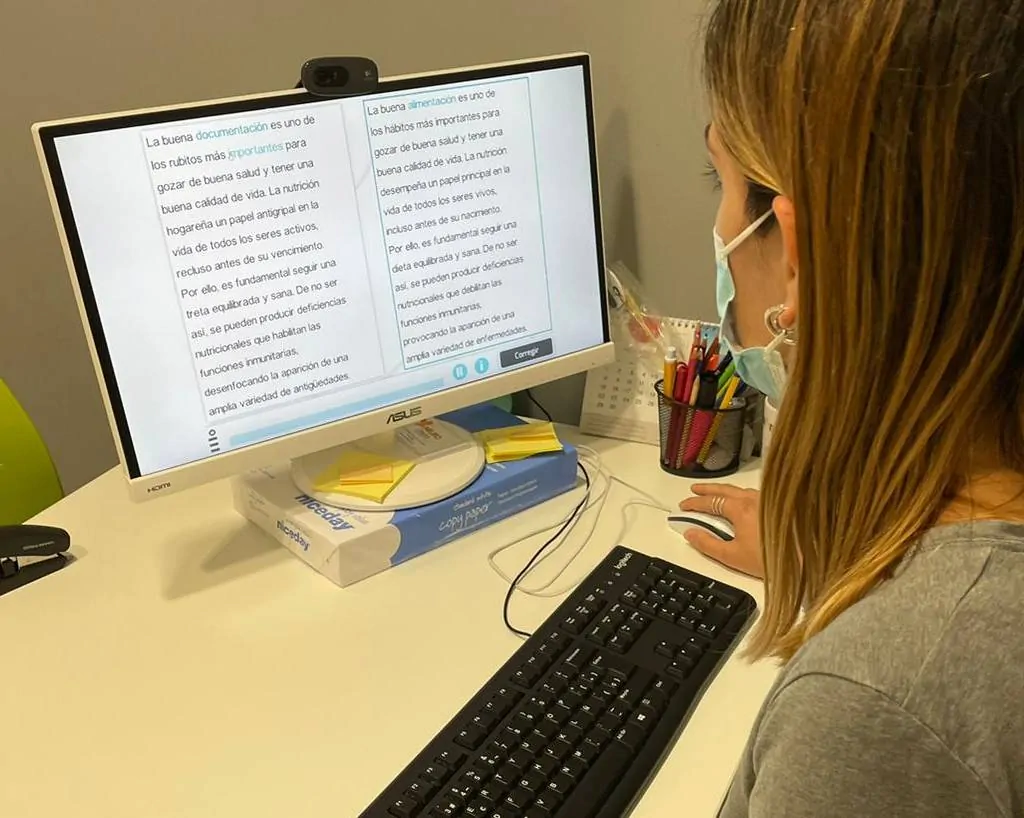
In this activity the patient must read the two texts alternately to detect the differences between them. As you can see, it is an activity that, like the previous one, requires good visuospatial scanning.
3. Organize the Bookcase
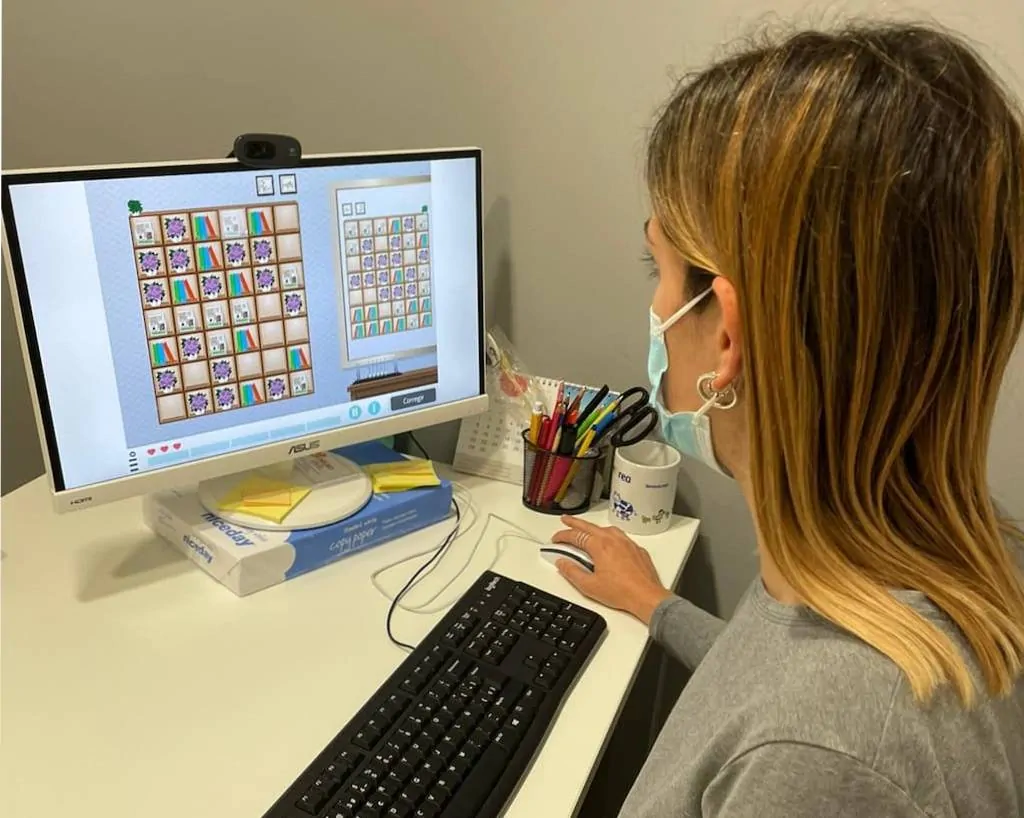
This activity is another example of how we can work on hemineglect. In this case, the patient has to make a mirror copy of the model bookcase. That is, the copy will not be correlative, but must be made in reverse, having to place the last stimulus of the model’s first row in the first place on the bookcase and so on consecutively. Thus, besides requiring correct visuospatial scanning, it also involves attentional capacity and the spatial relationship between stimuli.
It is very important that, whichever activity we use, we provide the person with compensatory strategies for the deficit so that they themselves, autonomously in their daily life, can give themselves those kinds of self-instructions and achieve optimal functionality.
2. Neuropsychological rehabilitation in children with neurodevelopmental disorders
Neurodevelopmental disorders include all disorders that occur due to an alteration or difficulty in the child’s typical neurological development.
Their impact can range from delays to significant alterations in the motor, cognitive, communicative and social areas.
As with intervention in acquired brain injury, prior to treatment a neuropsychological evaluation must be carried out. This should determine the child’s intellectual performance, their strengths and weaknesses, their affective state and the existence of disruptive behaviors. Through the results of the assessment and the information collected in the anamnesis, therapeutic objectives are established.
NeuronUP activities for neuropsychological rehabilitation in children with neurodevelopmental disorders
In interventions with children, it is very important to provide them with motivating tasks and activities that promote engagement and good adherence. For this reason, NeuronUP allows us to carry out specific, personalized cognitive stimulation with an attractive and fun design, ideal for the child to learn in a motivating way.
Below are some of the tasks we like most to work on attention and concentration in children:
1. Find the Lost Matches
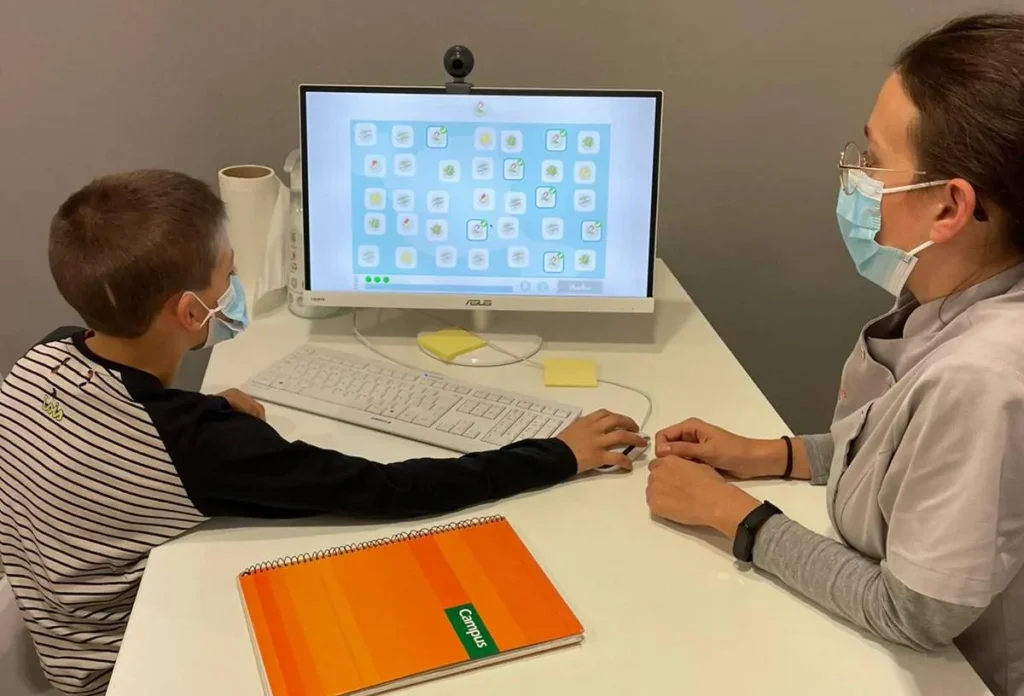
This activity consists of selecting the visual elements that are the same as the model. Thus, it is ideal for working on selective attention. We use it with children who have difficulties selecting only the target stimuli and/or with a tendency to impulsivity. It allows modulating the degree of difficulty, which will depend on the number of target stimuli and distractors presented (easier screens have fewer stimuli).
2. Counting
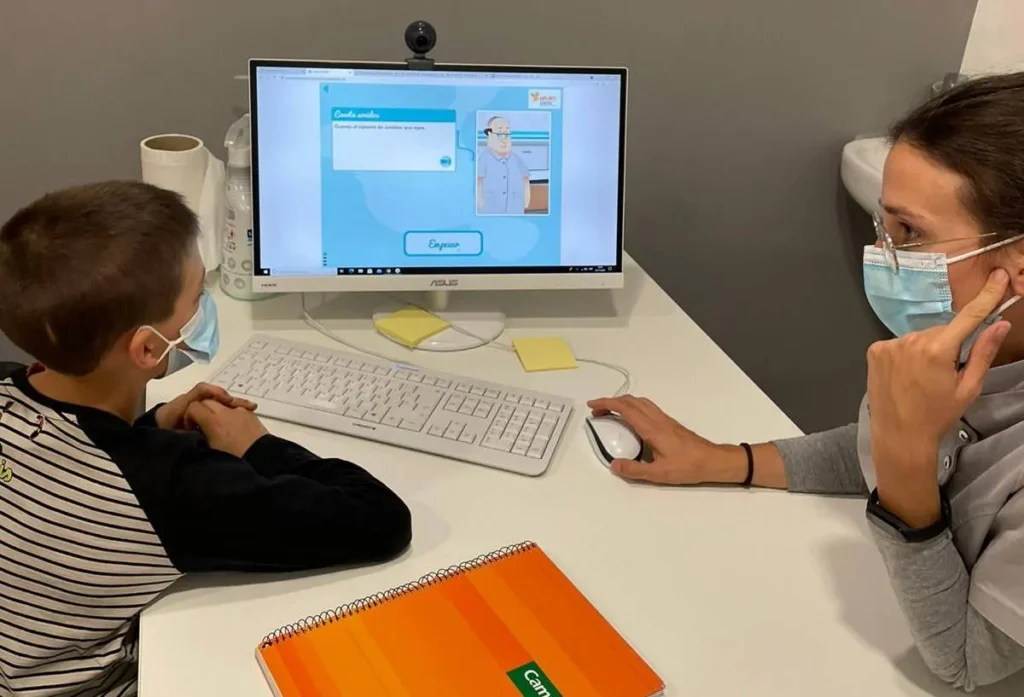
This activity allows us to work on the ability to attend to auditory stimuli by performing a Sound Counting task. In addition, it has an attractive format that children love and allows difficulty to be modulated so that it can be as personalized as possible.
We use it with children who have difficulties controlling attentional focus and who are prone to distractibility. Many times we start the activity at easy levels and with external aids (e.g., counting on fingers or counting aloud). Progressively, and depending on the child’s development, we use more complex levels and remove the aids.
3. Group cognitive stimulation for people with mild cognitive impairment and dementia
It targets people who have mild cognitive impairment, mild dementia or moderate dementia. The program is developed in a group format, with small groups of between 4 and 8 people, homogeneous according to the degree of cognitive impairment. Currently, we have 1 group of people with mild cognitive impairment, 2 groups with mild dementia and 1 group of people with moderate dementia.
The main objective of the program is to maintain and stabilize the participants’ cognitive and functional abilities as efficiently as possible and to slow the course of decline. In addition, among its objectives are improving psychological well-being and the quality of life of the patient and their family caregivers.
It is a multicomponent program because it encompasses the performance of cognitive, physical and occupational activities, which always include a psychoeducational component and a socializing and recreational basis. The program is carried out by professionals in neuropsychology, occupational therapy and physiotherapy.
All program activities are designed through systematic, structured planning adapted to the different capacities of the participants, in order to seek the maximum benefit for each participant.
NeuronUP activities for group cognitive stimulation in people with mild cognitive impairment and dementia
One of the main components of the program consists of cognitive stimulation activities, which involve an orderly and systematic performance of structured cognitive tasks. These tasks address different processes and cognitive abilities, with levels of complexity adapted to the different groups and degrees of cognitive impairment.
Thus, in the mild cognitive impairment group the cognitive abilities worked on mainly address episodic memory, attentional functions and executive functions (working memory, abstraction, cognitive flexibility, inhibition).
In the mild dementia group, the tasks performed include attentional functions, language, visuoperceptive functions, episodic memory, working memory and numerical reasoning. In the moderate dementia group, the activities carried out focus mainly on oral and written language, praxis, attention, visual gnosis and Autobiograhical Memory. These activities combine pencil-and-paper exercises and computerized activities.
The NeuronUP program has been of great help to us. The stimuli are very attractive and the feedback each exercise provides enhances participants’ motivation.
Below, we see participants from the mild dementia group performing very dynamic episodic memory activities that they find very interesting.
1. Memorize the order
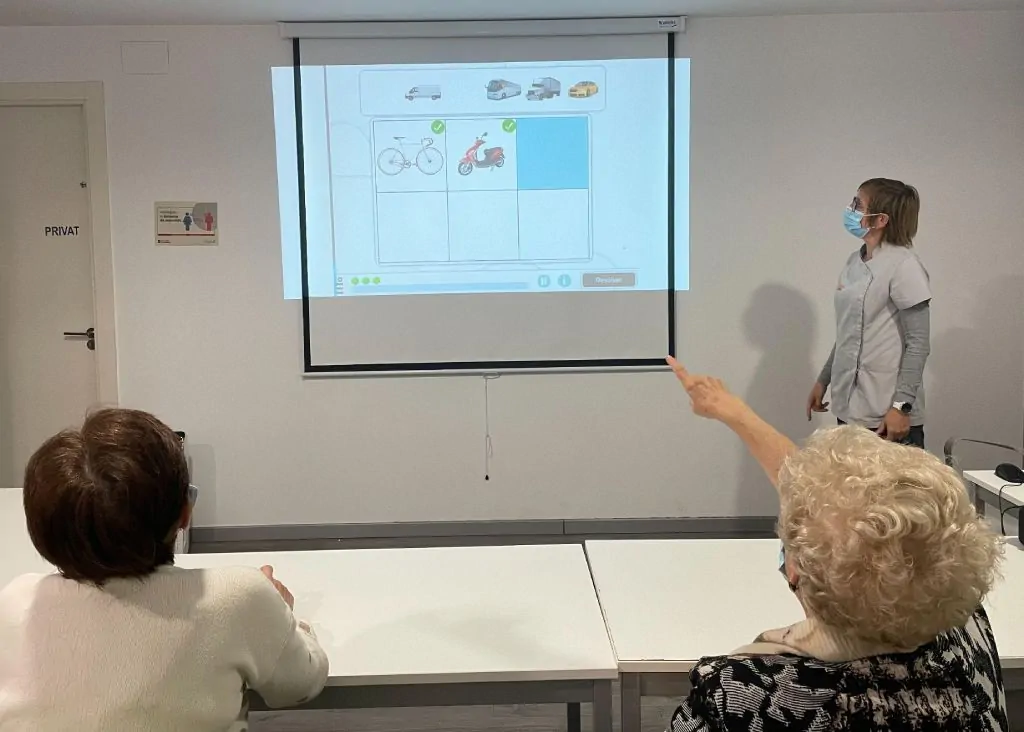
Memorize the order is a NeuronUP activity that consists of memorizing the images shown in order and then placing them in the same way. It is used to work on episodic memory.
2. Press Conference
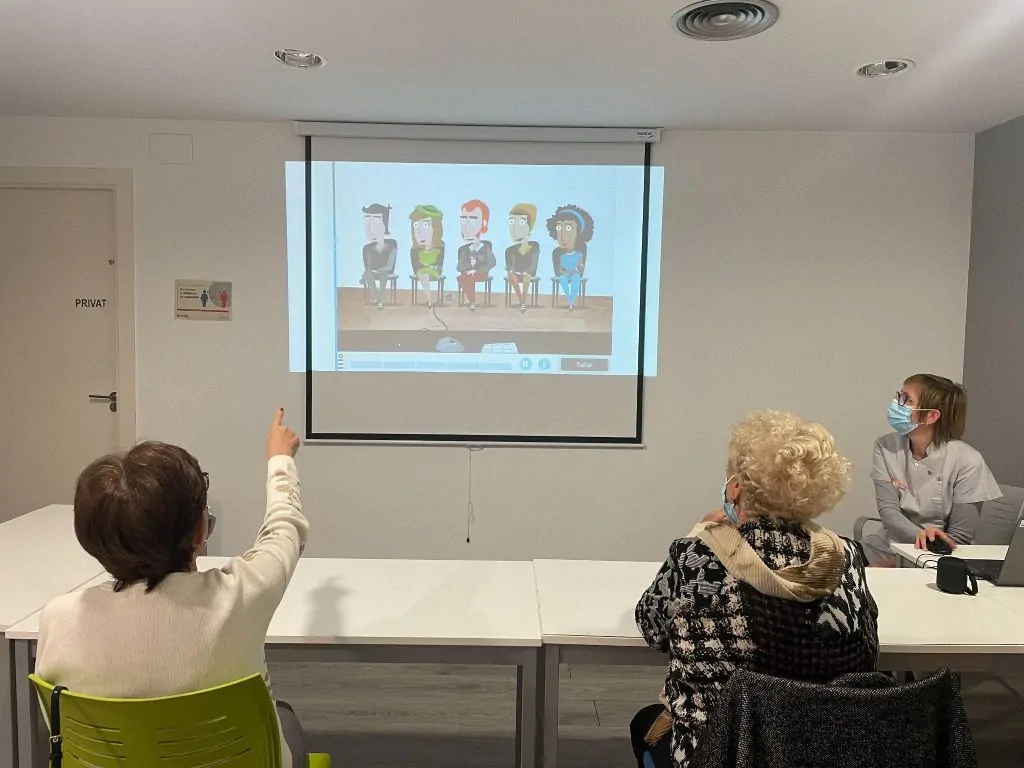
This activity involves remembering the order in which the journalists requested the turn to ask questions and reproducing it. In addition to episodic memory, it works working memory.
4. Group cognitive stimulation in people with acquired brain injury
The functional rehabilitation program is aimed at adults who have suffered an acquired brain injury or who suffer cognitive and physical deficits as a result of a neurodegenerative disease.
It consists of a group program of 3-5 people with the participation of three specialized disciplines: neuropsychology, physiotherapy and occupational therapy. They also share a common goal: to improve people’s functionality and autonomy in all areas (personal, family and social) and to guarantee maximum personal satisfaction.
Participants attend the center twice a week for two hours. In addition, an important component of this program are the activities that are carried out once a month in the community with visits to public facilities and resources and/or cultural places of interest in the area.
NeuronUP activities for neuropsychological intervention in people with acquired brain injury
The NeuronUP program, by offering different activities related to activities of daily living and the versatility of activities it offers, allows us to create sessions to work on different cognitive domains focused on the person’s daily life in order to offer solutions to the daily life problems of the affected person.
1. Accurate Payments

For example, as shown in the photograph, we have used the Accurate Payments task to work on cognitive functions such as attention and working memory.
2. Moving cubes

Other activities that we have used and that have been very well received by patients are tasks that work on visuospatial skills, such as Moving cubes. After performing the task, with the feedback the program offers us, we complement the task with psychoeducation and an evaluation of our performance taking into account our difficulties and assessing strategies and skills to be able to perform the task better.
If you liked this post about neuropsychological rehabilitation in neurological diseases, we recommend that you take a look at these publications:
“This article has been translated. Link to the original article in Spanish:”
Rehabilitación neuropsicológica en las enfermedades neurológicas
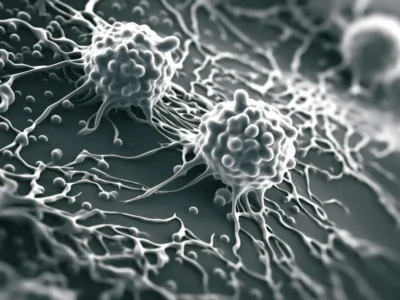

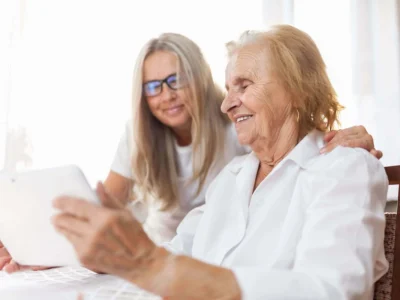
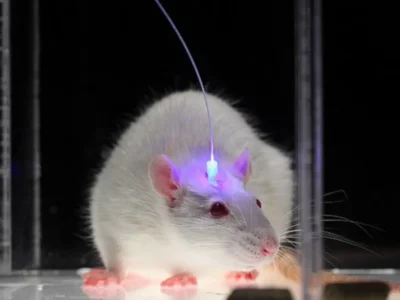

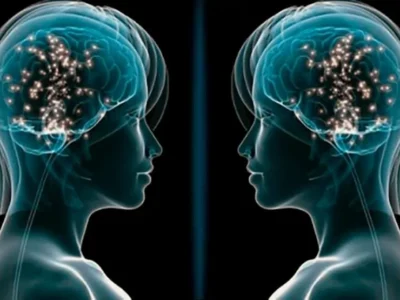
 Easter game for kids: Easter eggs
Easter game for kids: Easter eggs
Leave a Reply